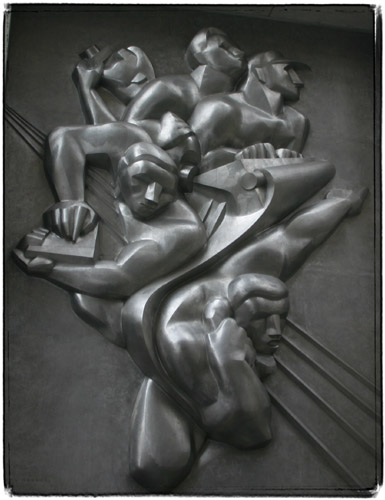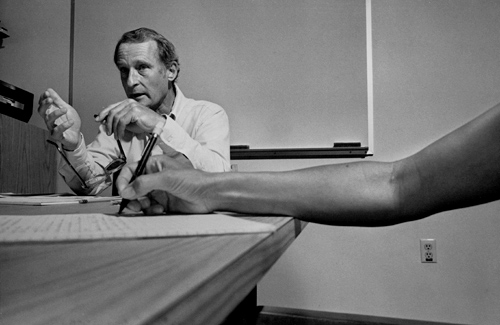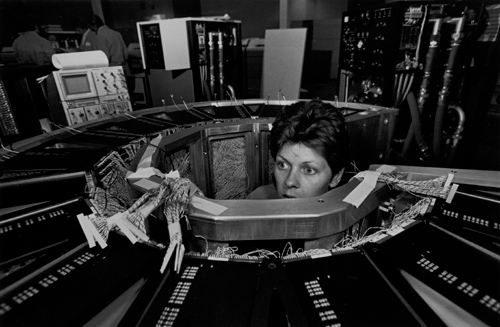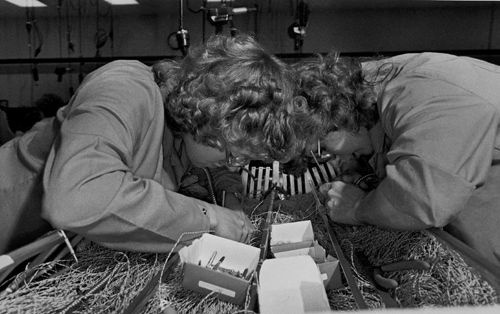October 2004 marks the 100th anniversary of the largest underground transit network in the world. Love it or hate it, if you’re a New Yorker, you can’t live without it: 3.5 million people ride the rails every day. The subway is as much a symbol of New York City as Central Park and the Statue of Liberty. Commemorating its centennial, this official publication presents an illustrated history of the architecture and design of the entire complex, from the interiors of the trains and the mosaic signage at the stations to the evolution of the token and the intricacy of the intertwined, rainbow-colored lines on the free, foldout map.
Produced with the New York City Transit Museum, Subway Style documents the aesthetic experience of the system through more than 250 exclusive pictures. The book includes newly commissioned color photographs of historic and contemporary station ornamentation as well as imagery from the Museum’s archives. The images span the full century, from the system’s inception in the early 1900s up to and including architectural renderings for the still-to-be-built Second Avenue line. AUTHOR BIO: The NEW YORK TRANSIT MUSEUM is one of only a handful of museums in the world dedicated to urban public transportation. The Museum’s collections of objects, documents, photographs, films, and historic rolling stock illustrate the story of mass transit’s critical role in the region’s economic and residential development since the beginning of the 20th century. The Transit Museum’s main facility is located in a decommissioned 1936 subway station in Brooklyn Heights, an ideal setting for the Museum’s 20 vintage subway and elevated cars, and wide-ranging educational programs for children and adults. A gallery annex in Grand Central Terminal presents changing exhibits relevant to the millions of commuters who use mass transit every day.
Photographer Andrew Garn has exhibited his work in galleries around New York City and across the country. His photographs are also held in numerous museum and private collections.
aka Offices are Very Small in Midtown
Isamu Noguchi’s “News” bas-relief on the front of Associated Press Building.

I call it “Photographer, Two Reporters, Copywriter and Copywriter’s Boyfriend”.
Die Kunst Der Rant : Shopping Cart Issue.
I don’t care what you call it – a shopping cart, a shopping bag or a shopping sack, but the following retarded things are going to cost you some sales:
1) Expire the shopping cart. There’s nothing that makes me want to complete my order than coming back in the morning and finding out that 20 items that I picked the night before are gone and my shopping cart is reset. Even better, store the cart id in a memory only cookie so that the cart will be reset even sooner.
2) Before checkout ask – “do you have a coupon”? Hey, the fact that there is a possibility that a coupon exists makes you feel that you are getting the _best_ possible price! Nobody is going to use that popular search engine dealy to try to find that coupon, and then to search for a better price on an item. No siree Bob.
3) Save money on copyrighter’s and photographer’s fees. A one line explanation and a tiny pixilated picture is enough. Even if the photographer gave you a big image file, that stuff will only confuse the customer. Product dimensions are irrelevant. I mean, what moron cant’s figure out the dimensions of a product from a tiny image with white background?
4) Don’t link the product in the shopping cart to the page with the description and photo of the product. A 10 pixel by 10 pixel image and a cryptic description is good enough. Who can forget what he added to the cart earlier?
Arrrrgh.
Psyops, The Non-Virtual Popunder and Stuff
You know those little subscription cards that fall out of magazines? They annoy the hell out of everybody. And apparently that’s why they are one of the most expensive and efficient advertising options in the print world. Same as a pop under ads online. You see, the reason they are put in magazines you already have a subscription for is the fact that they are very likely to fall out on a train, in a doctor’s waiting room, at the office or wherever good times are had. Kind of like psyop planes dropping leaflets on the enemy positions.
But here’s the interesting part. The damned cards have a name. They are called “blow-in cards”. They are named so because apparently they are placed into magazines by puffs of compressed air. They have even more annoying comrades – the bind-in cards that are as it’s clear from the name bound together with magazine pages. The thicker bind-in cards are kind of like permanent bookmarks making it hard to find any pages with actual information on them. I often go through a magazine ripping those out before reading.
Another interesting thing about blow-in technology is the way they make the card stay in place during the binding process. Most blow-in machines (how’s that for a profession – blow-in machine operator?) use static tacking. A special device creates a charge on the card and on the page so that they’ll stick. O’reilly books have this special binding that doesn’t work too well with regular blow-in machines, so people were complaining about blow-in cards that unintentionally became bind-ins. An interesting engineering solution followed:
With the old system, the cards were hit with a static charge to keep them in place as the cards moved through the binding machine. Sometimes, the card would lose the charge before getting all the way though. This new machine uses a miniscule bit of glycerin that holds the card in place longer and then fully disappears.
By the way, I have a whole collection of those O’reilly blow-in cards on the wall of my cubicle because they have those cool colophons with animals on them. I think Wrox books should have used baseball cards of developers for that purpose. With hilarious stats. That’s not a bad idea actually. Maybe they would have been better off if they had my marketing genius on their side. Still, with the money they saved on photographer’s services I am surprised that they went belly up.
In Linebarger’s “Psychological Warfare” I’ve read about sets of leaflets used by the Allies during WWII that had numbers on them. German kids collected those as stamps because of that (any collector will understand a desire to have the complete series). Those leaflets turned out to be extremely efficient because many adult Germans with collector kids had a full set in their house where they could safely study them.
This real world pop under kind of reminded me of banners that are being referred to as “Godzilla”, “gonzo” and “skyscraper” banners and popups. Some even have flash movies with this technology.
In the NAVY
I was looking for marine weather sites and found this..
Life in the NAVY is sweet. And not a single picture of latrine cleaning.
Hmm, this would make a really nice woodblock print.
Oooh, this is interesting: NAVY has a special set of ranks for photographers: “Photographer’s Mate 1st Class”, “Photographer’s Mate 2nd Class”, “Photographer’s Mate 3rd Class”. Hmm, I wonder how they earn promotions.
Here’s how. By taking exams!
Iiinteresting. Their insignia used to consist of a view camera,
 , but now now is this:
, but now now is this:  (an enlarger?).
(an enlarger?).
I really need some good military uniform and insignia books. Online resources suck.
Untitled
Ok, I’ve made an extravagant purchase. But I wanted it so, so much!
What was the object of my desire? It was a book of photographs called “Cray at Chippewa Falls”.It was an album by Lee Fridlander that was commissioned by Cray Research. The book was given to employees and was sold in Cray company store to visitors, but there were only about 5000 copies made.
The photographs are of unspeakable beauty. Friedlander starts with outskirts of Chippewa Falls – the waterfall, forest, fields. Then the photographs depict a typical small town – a railroad track, broken down pickup truck, suburban houses. Then the center of the town: a barber shop, Radio Shack, some fast food stores. Nothing extraordinary (except for Friedlander’s photographic talent). But then the magic begins. The book is full of photographs depicting highly concentrated men and women among chip making equipment, chassis of supercomputers with garlands of wires, computer terminals. Everybody is filled with a sense of purpose and pride – they are making the most advanced thinking machines in the world!
Seymour Cray, the Superman of Supercomputers

That’s Cray 1 in the background. Notice a nice little leather covered bench around the chassi. It was meant as a place where technicians could sit and warm themselves after spending a long time in an air conditioning room. In reality, few technicians would sit there for the fear of breaking the multimillion dollar machine.

Aaaaa! I am swallowed by a supercomputer!

That’s a lot of wires. But if they put their heads together…

Even though I paid $250 for this album (and it is worth every penny), the copyright of course does not belong to me. But I am pretty sure that showing you these photos falles under “fair use”.
From http://www.louisville.edu/~ddking01/mmgdl01.htm :
“Under these guidelines a photograph or illustration may be used in its entirety but no more than 5 images by an artist or photographer may be reproduced or otherwise incorporated as part of an educational multimedia project”
So if anybody asks – this is an educational multimedia project.